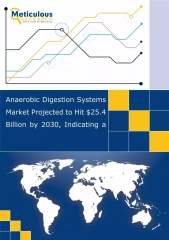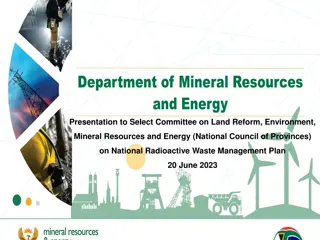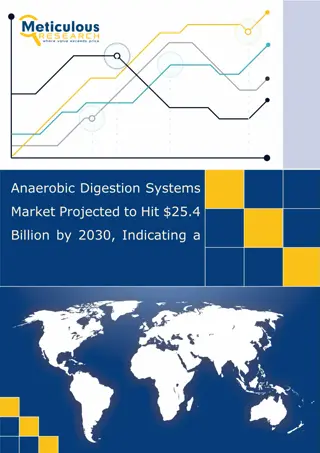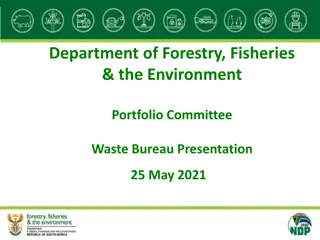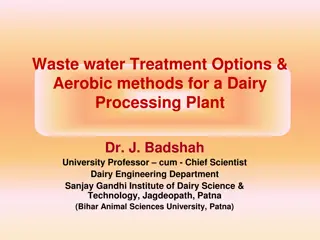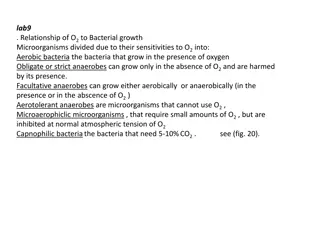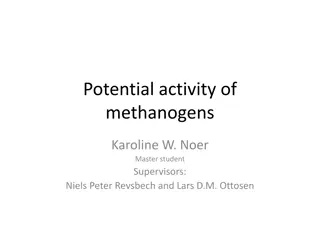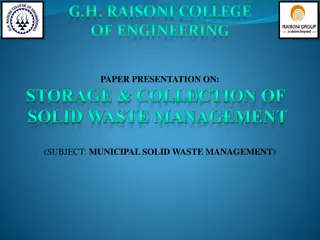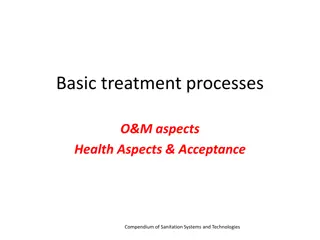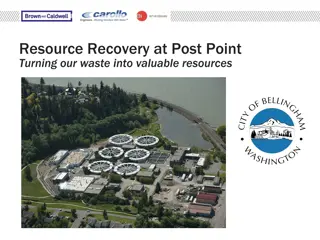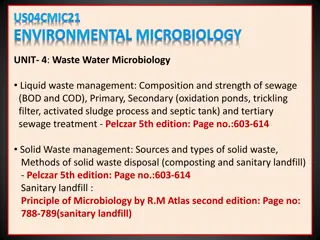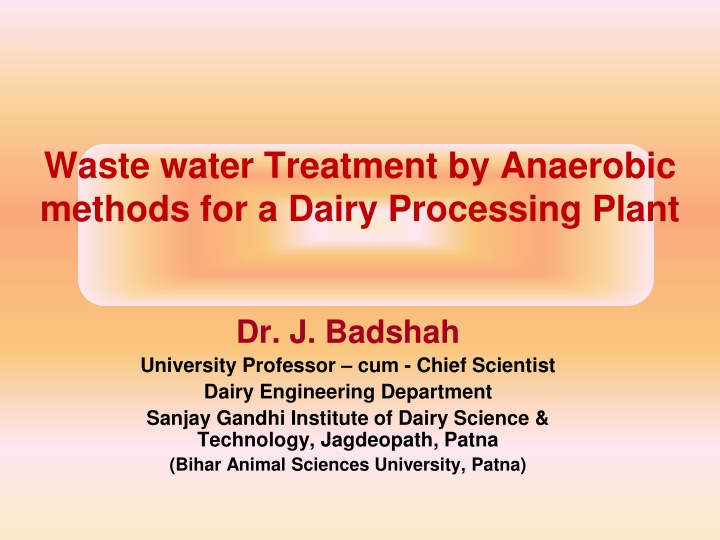
Anaerobic Methods for Dairy Wastewater Treatment
Learn about anaerobic biological systems for treating dairy wastewater efficiently, including benefits like methane production, reduced sludge generation, and lower nutrient requirements. Explore the advantages and disadvantages of anaerobic treatment in dairy processing plants.
Download Presentation

Please find below an Image/Link to download the presentation.
The content on the website is provided AS IS for your information and personal use only. It may not be sold, licensed, or shared on other websites without obtaining consent from the author. If you encounter any issues during the download, it is possible that the publisher has removed the file from their server.
You are allowed to download the files provided on this website for personal or commercial use, subject to the condition that they are used lawfully. All files are the property of their respective owners.
The content on the website is provided AS IS for your information and personal use only. It may not be sold, licensed, or shared on other websites without obtaining consent from the author.
E N D
Presentation Transcript
Waste water Treatment by Anaerobic methods for a Dairy Processing Plant Dr. J. Badshah University Professor cum - Chief Scientist Dairy Engineering Department Sanjay Gandhi Institute of Dairy Science & Technology, Jagdeopath, Patna (Bihar Animal Sciences University, Patna)
Anaerobic Biological Systems. Anaerobic performed by an active microbial consortium in the absence of exogenous electron acceptors. Anaerobic systems are economical for the biological stabilization of dairy wastes as they do not have the high-energy requirements associated with aeration in aerobic systems. Anaerobic digestion also yields methane, which can be utilized as a heat or power source. Furthermore, less sludge is generated, thereby reducing problems associated with sludge disposal. Nutrient requirements (N and P) are much lower than for aerobic systems. digestion (AD) is a biological process generally seen as more
Anaerobic Biological Systems. Pathogenic organisms are usually destroyed, and the final sludge has a high soil conditioning value if the concentration of heavy metals is low. The possibility of treating high COD dairy wastes without previous dilution, as required by aerobic systems, reduces space requirements and the associated costs. Bad odors are generally absent if the system is operated efficiently. The disadvantages associated with anaerobic systems are the high capital cost, long startup periods, strict control of operating conditions, greater sensitivity to variable loads and organic shocks, as well as toxic compounds. The operational temperature must be maintained at about 33 37 C for efficient kinetics, because it is important to keep the pH at a value around 7, as a result of the sensitivity of the methanogenic population to low values.
Anaerobic Biological Systems In anaerobic breakdown of dairy wastewater, lactose is first fermented to lactic acid and fats and proteins are hydrolyzed to organic acids, amino acids, aldehydes, and alcohols. Second, the intermediate organic compounds are converted to methane and CO2. Because anaerobic digestion does not require oxygen for decomposition operating costs for treatment are greatly reduced from that of aerobic treatments. The anaerobic digester is a large fermentation tank in which fermentation, sludge settling, sludge digestion, and gas collection take place simultaneously. Many dairy plants use a two-stage system in which the first stage is complete mixing of the contents of a fermentation tank and the second stage is a digester in which the contents are allowed to stratify. The two-stage anaerobic process allows for higher loading rates and shorter hydraulic retention times. of organic material,
Anaerobic Methods The anaerobic lagoon (anaerobic pond) Completely stirred tank reactors (CSTR) are, next to lagoons, the simplest type of dry matter m3/day and the digesters usually have capacities between 500 and 700 m3. These reactors are normally used especially those where the polluting matter is present mainly as suspended solids and has COD values of higher than 30,000 mg/L. In the CSTR, there is no biomass retention; consequently, the HRT and sludge retention time (SRT) are not separated, necessitating long retention times that are dependent on the growth rate of the slowest-growing bacteria involved in the digestion process. Ross found conventional digesters is equal to the SRT, which can range from 15 20 days. This type of digester has in the past been used by Lebrato et al. to treat cheese factory wastewater for concentrated wastes, that the HRT of the
Anaerobic Methods It is an anaerobic activated sludge process that consists of a completely mixed anaerobic reactor followed by some form of biomass biomass is recycled to the reactor, thus reducing the retention time from the conventional 20 30 days to ,1.0 day. Because the bacteria are retained and recycled, this type of plant can treat medium-strength wastewater (200 20,000 mg/L COD) very efficiently at high OLRs. The organic loading rate can vary from 1 to 6 kg/m3 day COD with COD removal efficiencies of 80 95%. The treatment temperature ranges from 30 40 C. A major difficulty encountered with this process is the poor settling properties of the anaerobic biomass from the digester effluent. The dairy wastewater was probably produced by a dairy with very good product-loss control separator. The separated
Options of Treatments for a dairy Processing Plant Treatment in nearby municipal treatment Plant facilities: i. Limitations of handling certain flow rates and peak loads ii. Limitation of handling Fat in dairy wastes iii. Limitation of handling discharge regulations of dairy wastes due to limited capacities of treatment facilities iv. High sewer treatment charges depending upon flow rates, BOD5, COD, Flow rates, SS and P contents etc. Employing Waste disposal contractors for removal of semisolids and wastes from the sites: i. Continuously impacted by increasing costs ii. Employing contractors for urgent removal of wastes is a limitation and problem iii. Control of BOD5, COD and SS as per regulation is stringent problem Onsite Treatments of wastes in own Waste treatment Plant of Factory: Aerobic alone or Aerobic and Anaerobic combination: i. Possible to control above limitation but sanitary discharges must be separate from organic dairy wastes ii. Generally preferable in a dairy plant
The upflow anaerobic sludge blanket (UASB) The upflow anaerobic sludge blanket (UASB) reactor was developed for commercial purposes by Lettinga and coworkers at the Agricultural University in Wageningen, The Netherlands. It was first used wastewaters in South Africa, but its full potential was only realized development program by Lettinga in the late 1970s. The rather simple design of the UASB bioreactor is based on the superior settling properties of granular sludge. to treat maize-starch after an impressive
The upflow anaerobic sludge blanket (UASB) Waste water flows upward throgh a sludge blanket composed of biologically formed granules On reaction, the gases produced under anaerobic conditions The free gas and granules attached to the gas rise to the top of the reactor where particles collide the baffle and the gases are released. The degassed granules typically drop back to the surface of the ssludge blanket which passes to the settling chamber. The gases are collected in in the collecting domes at the top of reactor
Anaerobic Attached Growth Process Anaerobic Filter Process: A column filled with various types of solid media Waste flows upward through the column and contact the media on which anaerobic bacteria grow and are retained. Because the bacteria are not washed off, the mean cell residence time of 100 days or larger for retention with short hydraulic retention times can be used even for low strength wastes at ambient temperature
Anaerobic Attached Growth Process Expanded Bed Process: A vertical bed of an appropriate medium such as sand, coal, expanded biological growth has been developed is used. The waste water is pumped upward through the bed Effluent is recycled to dilute the incoming waste and to provide an adequate flow using with BOD of 15000 t0 40000 mg/L. Used for municipal waste with low hydraulic retention time The recovery of methane is important advantage of all anaerobic processes aggregate on which

